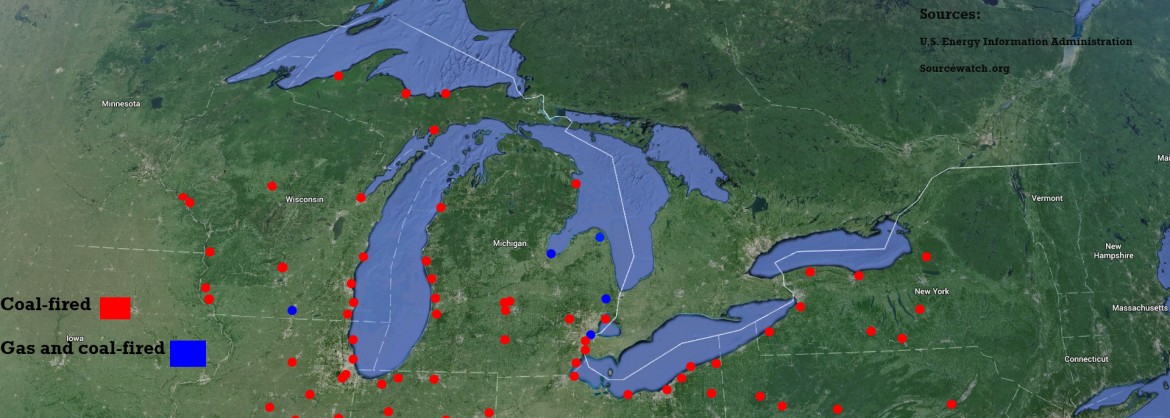 Even as environmental groups push for alternative energy sources across the Great Lakes Basin and as some lawmakers encourage efforts to reduce greenhouse emissions, most energy powering homes still comes from coal-fired generators.
Even as environmental groups push for alternative energy sources across the Great Lakes Basin and as some lawmakers encourage efforts to reduce greenhouse emissions, most energy powering homes still comes from coal-fired generators.
While electricity generated from coal has fallen in the past decade, from 5,453 to 4,345 megawatt hours per day nationally, the next three years are unlikely to see any such further decrease, according to a new report from the U.S. Energy Information Administration (EIA).
A megawatt-hour represents 1 million watts of electricity produced in an hour. That’s enough to power 1,000 homes for 60 minutes based on the standard 10,000-kilowatt energy use per home per year.
In its April 2014 Short-Term Energy Outlook Report, the EIA projects coal will remain the main source of electricity generation this year, outpacing the second-closest method, natural gas, 4,559 megawatt-hours to 3,002 megawatt-hours per day. Rounding out the top five fuel sources are nuclear with just above 2,000 megawatt hours, hydropower with 751 and renewable sources with 734.
The report’s findings are demonstrated in the Great Lakes region, where most states are net coal importers. In fact, Illinois, Indiana and Ohio were all in the top five coal destinations in the United States in the fourth quarter of 2013.
In Michigan, a state that imported more than 7 million short tons of coal in the final quarter of 2013, energy suppliers and environmental groups are working to change the energy paradigm. The term short ton refers to a weight of 2,000 pounds, compared to the British long ton of 2,204 pounds.
Last year, 54 percent of electricity flowing into Michigan homes and businesses came from coal-fired generators. And all of it arrived by train from other states, including Wyoming and Montana. This reliance on out-of-state fuel, coupled with increased natural gas production, has led several utilities in the state to explore — and sometimes to adopt — natural gas as a replacement.
Bob Ellerhorst, director of utility services at Michigan State University’s T.B. Simon Power Plant, said his plant has switched to using primarily natural gas for steam and power to the more than 500 buildings on campus.
The switch to natural gas also helps the plant reach the university’s emissions targets for 2015, which aims to reduce greenhouse emissions by 30 percent next year and ultimately by 65 percent by 2030, according to MSU Energy Transition. Ellerhorst noted that while there haven’t been any physical alternations to his plant’s generators, the change-over to natural gas has significantly decreased its greenhouse emissions.
When it comes to biofuel, the plant has experimented with various forms including burning tree trimmings and foliage from campus, as well as importing energy-dense wood.
However, Ellerhorst said the plant can’t now make a significant swing toward these energy sources. “We are able to maintain capacity using coal and natural gas, but we would be unable to maintain these levels using biofuels.”
He added that switching to natural gas has had more impact on greenhouse emissions than biofuels thus far. For now, the plant will continue experimenting with emerging biofuels and ensure stability in production through traditional methods.
A few miles away in Lansing, a battle is brewing between local municipal utility Lansing Board of Water and Light (BWL) and the Michigan Sierra Club over what to do with the coal-fired Eckhart Power Plant.
Brad Van Guilder, an organizer with the Sierra Club, said serious consideration of closing the Eckert plant began in 2008, when a number of new coal facilities were being planned for Michigan, including an additional plant in Lansing. Numerous discussions with BWL resulted in the Reo Town Cogeneration plant, the first natural gas cogeneration plant operated by the utility.
With this new facility, Van Guilder said Lansing and the nearby community’s that also obtain power from BWL no longer needs the 60-year-old Eckert plant to provide the capital region’s energy needs. BWL would need to replace between 70-140 megawatts of energy to maintain capacity, which the Sierra Club maintains should be done through increased efficiency and buying energy from the existing electrical grid.
Other obstacles for the aging Eckert plant include impending environmental regulations and energy economics. The plant can’t currently meet new federal Mercury and Air Toxic Regulations set to take effect in 2015 without major, expensive pollution controls. While BWL received a one-year extension to evaluate future options, the utility would be able to ask for only one more year of exemption before having to either close the plant or install effective pollution reduction tools.
The economics of running a coal-fired plant are also increasingly more expensive, according to Van Guilder. That’s because new alternative energy solutions, including solar power, are becoming cheaper as the technology becomes more widely available.
Apart from regulations and shifting economics, the Sierra Club maintains the plant has an adverse impact on the public health of nearby residents. The plant is the largest polluter in the tri-county area, according to Van Guilder, and data shows the highest concentration of asthma-related hospitalizations among people living near the plant.
In the next five years, Van Guilder said utility companies and citizens will have to adopt a new understanding of regional energy providers.
“It’s really important for people to understand utilities will be changing, from power generators to an energy service provider,” he said. Instead of producing all of an area’s power, utilities are expected to buy electricity from larger plants, while maintaining smaller and greener facilities.
